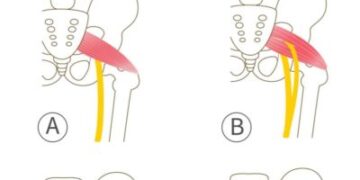Understanding lower back pain - lumbago
Lumbago - Understanding lower back pain: Important information for you
Imagine you are lifting a heavy suitcase, moving a massive box or weeding the garden and suddenly a sharp pain shoots into your lower back or lumbar spine. This is often referred to as "Lumbago" which is medically referred to as "Lumbago" or "local lumbar syndrome" is known.
Lumbago is often caused by sudden movements under strain that lead to muscle stiffness. This can restrict the mobility of the lumbar spine and cause severe, acute pain in the lower back. Causes can be blocked joints in the vertebral bodies or pinched nerves. Poor posture, imbalances in the muscles between the trunk and back or a lack of movement can also trigger lumbago.
Pain in the back
Characteristic symptoms of lumbago
The pain is often localized in the lower back, but can also radiate to the buttocks, thighs or groin region. All movements of the lumbar spine are painful or restricted. The pain can be deep, pulling or stabbing, and the affected region often feels cramped and warm. Symptoms such as sciatic nerve pain radiating to the legs are also possible.
If you also experience numbness or tingling in your legs, it is important to see a doctor immediately to rule out more serious problems such as a slipped disc or discomfort in the area of the sciatic nerve.
Treatment approaches
Self-help for acute Back pain
Rest should be the top priority for the first two to three days. However, it is not advisable to stay in bed. Instead, you should move around without straining. Movement promotes blood circulation and helps to carefully mobilize the vertebral joints. Change position frequently (lying, sitting and standing) without exceeding the pain threshold. Heat applications, such as hot water bottles, warm baths or ointments, can have a relaxing effect and promote blood circulation. Anti-inflammatory painkillers or topical ointments can be helpful for severe back pain, but their use should be supervised by a doctor.
Physiotherapy as an effective measure against lower back pain
Physiotherapy treatment is crucial to support the healing process and prevent future back pain. Physiotherapy can include:
Exercises to alleviate pain and relieve the lower back: These help to mobilize the affected areas.
Stretching and mobilization exercises: Promotion of mobility and reduction of pain through Piriformes syndrome or sciatic nerve pain. Treatment of the Trigger points.
Back training and postural gymnastics: Teaching correct postures and movement patterns for everyday life.
Advice on lifting loads: Tips and techniques to protect the back, especially the lumbar spine, e.g. when lifting heavy loads from the floor.
Strength training for the back and core: Building up a stable musculature to prevent further complaints.
These measures provide relief and at the same time promote long-term back health.
Medical clarification for persistent sciatic nerve pain
If the symptoms do not subside or even worsen after four to seven days, a specialized medical examination is advisable. The doctor can determine the exact cause of the pain through targeted diagnostics, such as imaging procedures, and initiate appropriate treatment.
Prevention: How to protect yourself from further back pain
Preventive measures are essential to prevent back pain from recurring. Here are some tips that you should integrate into your everyday life:
Regular exercise: An active lifestyle is important. Even short walks can help.
Ergonomics at the workplace: Ensure that your furniture is back-friendly and that your posture is correct.
Training for the torso: Targeted exercises strengthen the back muscles and improve posture.
Correct lifting: Heavy loads should be lifted from the legs, keeping the knees bent and the back straight. This protects against lumbago and complaints caused by piriformis syndrome in particular.
You can keep your back healthy and pain-free with these preventive measures and appropriate treatment for acute complaints. Stay active and listen to your body's signals. One professional physiotherapeutic Support can help you to promote your back health in the long term and prevent future back pain. Here you can Book an appointment.
Categories
- Osteoarthritis
- Leg
- Extensions
- Dry needling
- Elbow
- Foot
- Balance
- Hand
- Hip
- Pine
- Knee
- Headache
- Lymphatic drainage
- Mobilization
- Muscle pain
- Myofascial therapy
- Neck pain
- Physiotherapy Höngg
- Physiotherapy Wipkingen
- Physiotherapy Zurich
- Rehabilitation
- Back pain
- Shoulder arm
- Shoulder pain
- Pregnancy
- Dizziness
- Sports
- Trigger points
- Exercises
- Lower leg
- Injury prevention
- Wade
- What to do?
- Wound healing
Put an end to office back pain in Zurich Wipkingen
Put an end to office back pain Do you know what it's like? A long working day, lots of screen time - your neck gets...
Read moreStretching program
Your stretching program Stretching is an essential foundation for your mobility and well-being....
Read moreWorkplace ergonomics - Do you work at a computer?
Ergonomics at the workplace: Effective measures to combat back pain and neck tension You're probably familiar with...
Read moreBack pain: understanding and solutions
Back pain: can have many causes Back pain is one of the most common complaints that affect people....
Read moreLumbago - What really helps to relieve the pain
Lumbago - Understanding lower back pain: Important information for you Imagine you are lifting...
Read morePiriformis syndrome - What helps against pain in the buttocks?
Piriformis syndrome and lumbago at a glance What is piriformis syndrome? Piriformis syndrome is a...
Read moreBack pain - causes, symptoms and treatment options
Back pain - causes, symptoms and treatment options Back pain is a widespread problem.
Read more









